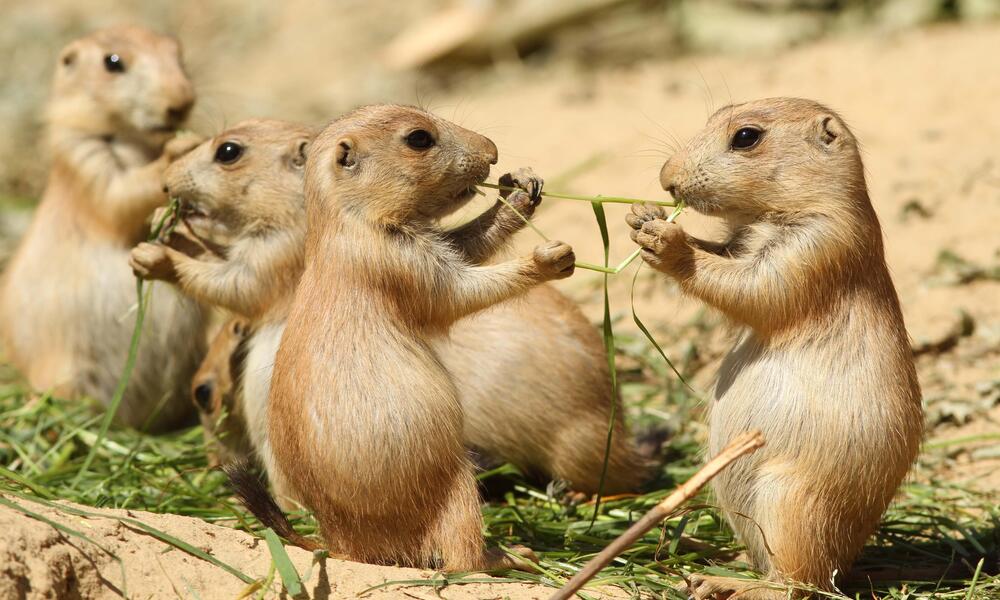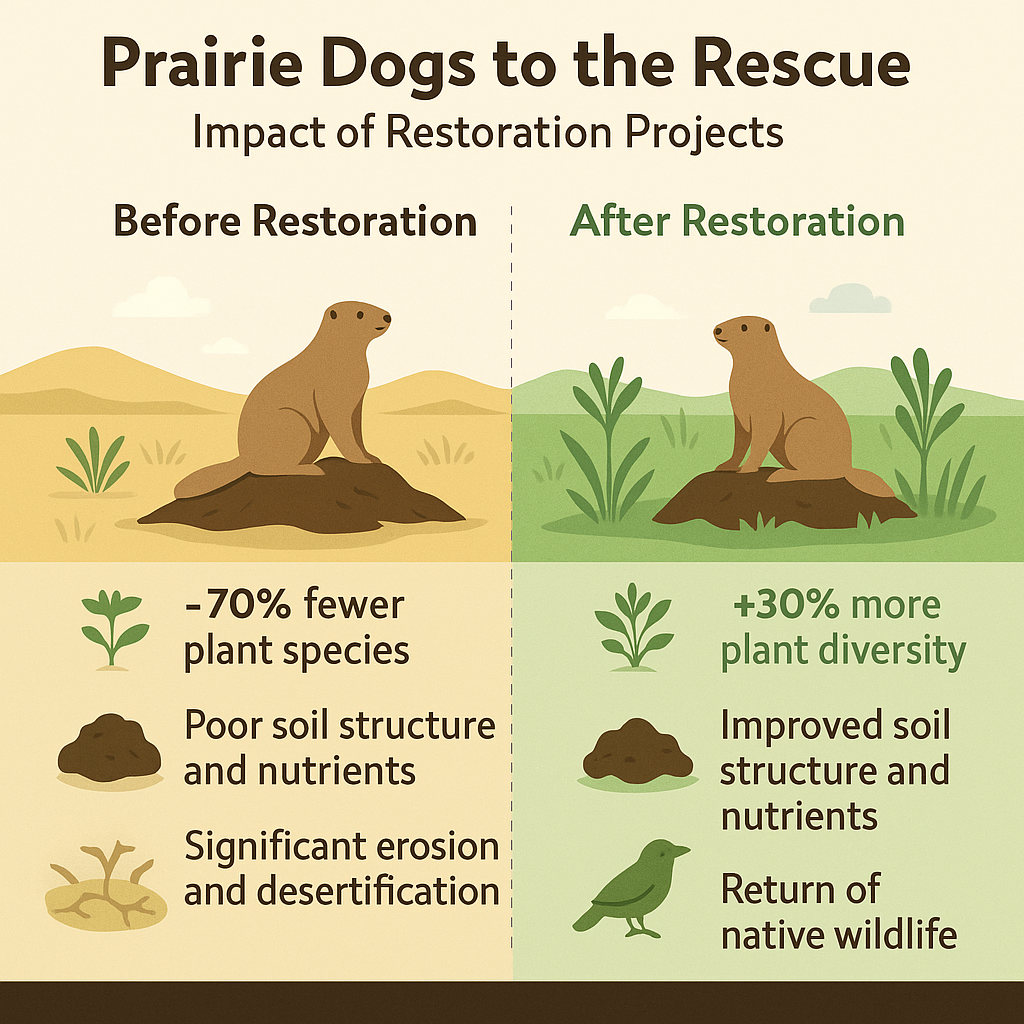The Role of Prairie Dogs in Preventing Desertification
Introduction:
Tiny Architects of the Grasslands
When you think of environmental superheroes, prairie dogs probably don’t make your top ten list. After all, they’re small, chubby ground squirrels known mostly for popping out of holes and chirping at predators. But these tiny rodents are surprisingly crucial in the battle against desertification a process that turns fertile land into deserts due to poor land management, climate change, and biodiversity loss.
Found throughout North America’s grasslands, prairie dogs are considered a keystone species, meaning their presence has a disproportionately large effect on the ecosystem. By digging, nibbling, and simply living their lives, prairie dogs help maintain healthy grasslands nature’s green barrier against desert spread.

Understanding Desertification: A Silent Environmental Crisis
Desertification is not the creation of new deserts but rather the degradation of land in arid, semi-arid, and dry sub-humid areas. It’s a creeping problem fueled by:
- Overgrazing
- Deforestation
- Unsustainable agriculture
- Climate change
- Soil erosion
As vegetation disappears, the soil loses its structure, becoming loose, dry, and prone to erosion by wind and water. If this process isn’t stopped, vast areas can turn into barren wastelands.
Enter the Prairie Dog: Ecosystem Engineers
Prairie dogs are like the gardeners of the Great Plains. They dig complex underground burrows, graze selectively on grasses, and create a habitat that supports a variety of plant and animal species. These actions play a direct and indirect role in halting or even reversing desertification.
1. Soil Aeration and Water Retention
Prairie dogs are prolific diggers. Their burrowing:
- Aerates the soil: By mixing soil layers, they improve air and water infiltration.
- Prevents compaction: This makes it easier for plant roots to grow.
- Enhances water retention: Their tunnels help water seep deeper into the soil, reducing surface runoff and improving drought resistance.
This increased water absorption is critical in semi-arid regions where water is scarce and every drop counts.
2. Natural Fertilizers
Their droppings and decomposing plant matter within the burrows enrich the soil with nutrients. Think of prairie dogs as natural composters. Their activities increase nitrogen levels in the soil, leading to healthier plant growth and a more robust ground cover both essential for preventing erosion.
3. Encouraging Plant Diversity
Prairie dogs are selective grazers. They trim tall grasses that would otherwise dominate and shade out other plants. This promotes:
- Plant diversity: More species thrive in prairie dog towns than in areas without them.
- Ground cover: Diverse plant life leads to better coverage of the soil, reducing exposure to wind and sun two major contributors to desertification.
A well-covered soil is less likely to blow away or dry out, keeping the land fertile.
4. Erosion Control
By holding the soil together through both vegetation and burrowing systems, prairie dogs reduce the risk of:
- Wind erosion (especially in flat plains)
- Surface water runoff after rainfall
- Gully formation from heavy water flow
Their presence acts like a glue holding the landscape in place.
🐾 Prairie Dogs: The Grassland’s Keystone Engineers
Prairie dogs are burrowing rodents belonging to the squirrel family (Sciuridae) and are native to the grasslands of North America. There are five recognized species:
- Black-tailed prairie dog (Cynomys ludovicianus)
- White-tailed prairie dog (Cynomys leucurus)
- Gunnison’s prairie dog (Cynomys gunnisoni)
- Utah prairie dog (Cynomys parvidens)
- Mexican prairie dog (Cynomys mexicanus)
They live in colonies, often called “towns,” which can span hundreds of acres. Their intricate tunnel systems include multiple chambers for nesting, food storage, and escape from predators. The social structure within colonies is sophisticated, including family groups known as “coteries.”
Despite their modest size—typically 12 to 16 inches long and weighing 1 to 3 pounds—prairie dogs are among the most influential animals in their ecosystem. Here’s how:
🛠️ Ecosystem Engineering:
Prairie dogs physically modify their habitat through burrowing, which has numerous benefits:
Improved soil aeration, helping root systems thrive.
Enhanced water absorption, especially vital in drought-prone grasslands.
Increased nutrient cycling by bringing subsoil to the surface and spreading organic material.
🌱 Regulating Vegetation:
Prairie dogs selectively graze on grasses and forbs, trimming dominant species and allowing less competitive plants to flourish. This practice enhances plant diversity and results in a more balanced and stable ecosystem.
🦉 Supporting Other Wildlife:
Their burrows serve as safe havens for over 150 species, including:
Burrowing owls, which nest inside abandoned burrows.
Black-footed ferrets, an endangered species that rely almost entirely on prairie dogs for both shelter and food.
Snakes, lizards, and insects, all of which find refuge in prairie dog towns.
Their importance is so substantial that losing prairie dogs can lead to ecological collapse in areas that once thrived under their presence.

Consequences of Prairie Dog Decline
Over the last century, prairie dog populations have plummeted by more than 95%. This dramatic decline is due to a combination of human actions, disease, and land use changes.
Human Conflict and Eradication:
Prairie dogs have long been considered agricultural pests by farmers and ranchers. The main concerns include:
Competition with livestock for forage.
Livestock injuries from burrow holes.
Damage to equipment or land value.
This has led to widespread extermination efforts through poisoning, shooting, and bulldozing of colonies. For example:
- In the 20th century, U.S. federal programs treated millions of acres with rodenticides aimed at removing prairie dogs.
- In Mexico, the Mexican prairie dog is now endangered, primarily due to conversion of its habitat into cropland.
🦠 Disease Threats:
Prairie dogs are highly susceptible to sylvatic plague, a disease caused by the Yersinia pestis bacterium and transmitted by fleas. This plague can wipe out entire colonies within weeks and has been one of the major biological threats to their survival.
🌵 Environmental Fallout:
As prairie dog numbers decrease, so does their influence on the environment, causing a domino effect:
Soil Degradation: Without burrowing, soils become compacted, reducing aeration and water absorption.
Increased Erosion: Lack of diverse vegetation and poor soil health lead to greater wind and water erosion.
Desertification: Especially in semi-arid regions like the Chihuahuan Desert, removal of prairie dogs has led to rapid vegetation loss and land degradation.
Loss of Biodiversity: Species that depend on prairie dogs—like the black-footed ferret—also face extinction.
A study in New Mexico’s grasslands found that areas without prairie dogs had 70% fewer plant species, less fertile soil, and far more signs of erosion and desert creep than adjacent prairie dog-occupied zones.
🌱 Restoration Projects: Prairie Dogs to the Rescue
Recognizing the ecological importance of prairie dogs, scientists, conservationists, and even ranchers have begun working to reintroduce and protect them. These efforts are proving that restoring prairie dog populations can rejuvenate entire landscapes.
📍 Case Study: Janos Biosphere Reserve, Mexico
In northern Chihuahua, prairie dog populations were reintroduced into degraded grasslands of the Janos Biosphere Reserve. The results were dramatic:
- Within just 3 years, plant diversity increased by over 30%.
- Soils showed improved structure and nutrient content.
- Native wildlife, including burrowing owls and grassland songbirds, began returning.
📍 U.S. National Grasslands Projects
In areas like the Buffalo Gap National Grassland in South Dakota and Thunder Basin in Wyoming, controlled reintroduction of prairie dogs is used to combat land degradation and encourage biodiversity.
Key elements of these programs include:
- Use of plague-resistant populations or flea treatments to control disease spread.
- Partnerships with private landowners to promote prairie dog-friendly rangeland management.
- Educational outreach to dispel myths about prairie dog-livestock competition.
💡 Innovative Techniques in Restoration:
- Translocation: Moving healthy prairie dog colonies from urbanized or threatened areas to protected reserves.
- Vaccination Programs: Testing oral vaccines against plague in field conditions to build herd immunity.
- Habitat Corridors: Creating natural corridors that connect prairie dog colonies, allowing gene flow and wider ecosystem impact.
- Bioacoustic Monitoring: Using prairie dog vocalizations to monitor colony health and behavior.
👨🌾 A Shift in Ranching Perspective
Forward-thinking ranchers are learning that coexisting with prairie dogs can be more beneficial than extermination. Some benefits include:
- Improved grass regrowth due to selective grazing.
- Reduced fire risks because prairie dogs clip vegetation, creating natural firebreaks.
- Opportunities for ecotourism and conservation incentives.
One example is in Colorado, where ranchers working with conservation groups were able to improve their rangeland productivity and even generate income by allowing wildlife tours in active prairie dog towns.
🧭 Looking Ahead: Prairie Dogs as Partners in Restoration
Restoring prairie dogs isn’t just about saving one species—it’s about healing entire ecosystems. As global desertification accelerates due to climate change and unsustainable land use, we need natural allies like prairie dogs more than ever.
Future strategies should include:
- Cross-border conservation: Since prairie dogs roam across the U.S.–Mexico border, bi-national cooperation is key.
- Climate resilience planning: Using prairie dogs in land restoration plans to help landscapes adapt to changing rainfall and temperature patterns.
- Community-based stewardship: Engaging local communities in protecting prairie dog habitats for long-term sustainability.

Human Perception vs. Ecological Reality
Unfortunately, prairie dogs are often seen as pests, especially by ranchers. Concerns include:
- Competition with livestock for grass
- Damaging equipment due to burrows
- Spreading disease
However, numerous studies have shown that prairie dog presence does not significantly reduce available forage for cattle and may even improve rangeland productivity by increasing the nutritional value of plants. Some ranchers are now working with conservationists to integrate prairie dogs into sustainable land-use models.
Lessons from the Prairie: How We Can Help
To protect prairie dogs and prevent desertification, we need a combination of science, education, and policy changes:
- Public Awareness: Help communities understand the ecological value of prairie dogs.
- Landowner Incentives: Encourage coexistence by compensating ranchers or offering tax breaks.
- Habitat Protection: Safeguard remaining grasslands from development and overgrazing.
- Reintroduction Programs: Restore prairie dog populations in degraded landscapes.
- Research and Monitoring: Track changes in vegetation, soil, and biodiversity.
Conclusion: The Underdog Heroes
Prairie dogs may not wear capes, but their ecological impact is profound. By maintaining soil health, supporting biodiversity, and enhancing plant growth, they form the first line of defense against desertification. Their survival is closely linked to the health of entire ecosystems across North America.
So next time you see one pop out of a burrow and chirp, know that this little creature is doing much more than just being cute it’s fighting a quiet war against the deserts of tomorrow.